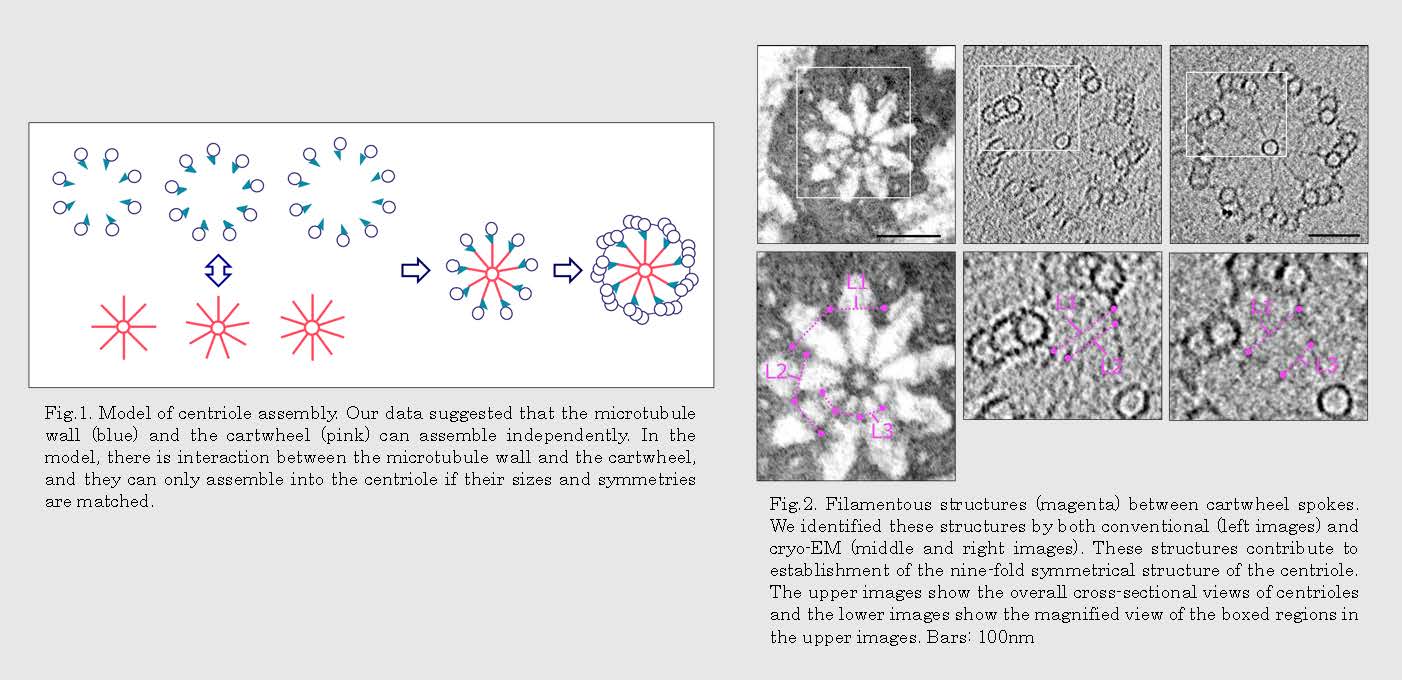CLS
Laboratory for Chemistry and Life Science, Institute of Innovative Research, Tokyo Institute of Technology
東京工業大学
科学技術創成研究院
化学生命科学研究所

LAST UPDATE 2023/08/08
-
研究者氏名
Researcher Name苗加彰 Akira NOGA
特任助教 Specially-appointed Assistant Professor -
所属
Professional Affiliation東京工業大学科学技術創成研究院化学生命科学研究所
分子生命化学領域
Laboratory for Chemistry and Life Science, Institute of Innovative Research, Tokyo Institute of Technology
Molecular bioscience -
研究キーワード
Research Keywords繊毛
中心子
クラミドモナス
Cilia
Centriole
Chlamydomonas
- 研究テーマ
Research Subject -
中心子(繊毛基底小体)の9回対称性構造を規定する機構
Mechanism that establishes nine-fold symmetry of centriole (ciliary basal body)
研究の背景 Background
繊毛は真核生物に広く保存された細胞小器官であり、細胞運動や物質の輸送を行い、「9+2構造」という9本の周辺微小管を基本とする普遍的な構造をもつ。この構造を規定しているのが中心子(基底小体)であり、回転対称に配置された9本の三連微小管からなる。この9回対称性構造の構築機構に働くタンパク質は明らかになってきたが、それらがどのように機能するかは不明な点が多い。
Cilia are conserved organelles in eukaryotes that are involved in cellular motility and material transportation. This organelle has ‘9+2 structure’ a conserved structure characterized by nine peripheral microtubules. This structure originates from the centriole (basal body), consisting of nine triplet microtubules arranged rotationally. Although proteins responsible for establishing the nine-fold symmetry of the centriole has been identified, their precise functional roles remain largely unknow.
研究の目標 Outcome
中心子の9回対称性構造の構築機構の解明を目指し、中心子タンパク質の機能・構造解析を行っている。細胞生物学における大きな発見になるだけではなく、中心子の異常によって、ガン化や、小頭症、内臓逆位が起こることが知られており、本研究はこれらの疾患の理解につながると期待される。
Our aim is to elucidate the mechanism that establishes the nine-fold symmetrical structure of the centriole. To this end, we are carrying out the functional and structural analyses of centriolar proteins. This accomplishment will have a major impact on the field of cell biology and will advance the understanding of diseases such as cancer, microcephaly, and situs inversus because abnormalities in the centriole lead to these diseases.
研究図Research Figure

Fig.2. Filamentous structures (magenta) between cartwheel spokes. We identified these structures by both conventional (left images) and cryo-EM (middle and right images). These structures contribute to establishment of the nine-fold symmetrical structure of the centriole. The upper images show the overall cross-sectional views of centrioles and the lower images show the magnified view of the boxed regions in the upper images. Bars: 100nm
文献 / Publications
Noga, A., Horii, M., Goto, Y., Toyooka, K., Ishikawa, T., Hirono, M. (2022) EMBO Journal 41: e104582 (2022)
Hilbert, M*., Noga, A*., Frey, D., Hamel, V., Guichard, … Gönczy, P., Hirono, M., Steinmetz, MO. Nature Cell Biology 18: 393 (2016) (* equal contribution)
研究者HP
- noga.a.aa
 m.titech.ac.jp
m.titech.ac.jp - http://www.res.titech.ac.jp/~biores/about.html#members